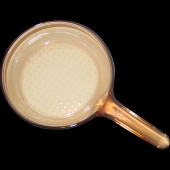Jennifer Richardson wrote:So I found a couple of old iron smoothing irons upstairs (pictures below) and wondered if anyone had any experience using them.
They are rusted and rough. Normally to restore old cast iron cookware I would polish them up with steel wool and season them, but I'm guessing I don't really want any seasoning on my iron!
It's my belief that you actually
do want them seasoned.
Because of my folks' "back to the land" schemes in the early 1970s I grew up living the frontier lifestyle on the Yukon River, complete with no utilities of any kind and all-wood heat. My mother had quite a few of the old sad-irons (as they are called) because she was a bottle digger and amateur archaeological excavator of garbage middens and 1900s-vintage homesites. She also had several of the iron-shaped cast iron trivets.
We had and used a LOT of cast iron in our cabin, virtually all of it more than sixty years old and refurbished after sitting in the moss and soil for many decades. Mom didn't use the sad-irons very much (the lifestyle didn't call for a lot of ironing) but I do recall her heating them up for a variety of dress-making projects (she had a formerly-electric Singer sewing machine with zig-zag stitching that my dad frankensteined into the body of an antique treadle Singer).
My memory -- which could be wrong -- is that she seasoned them the same way she seasoned all of her other refurbished cast iron. She'd use (or have her children use) steel wool to remove the gross rust, and then she'd slather or soak the cast iron in Wesson oil (a brand of food vegetable oil) and cook it in a hot oven for a few hours. Then she'd perch it somewhere on a hot stovetop (we had two wood stoves going full blast most of the time) for hours or days longer to let the seasoning set up.
The thing about good seasoning on cast iron is that it's smooth but not oily. There isn't actually any oil present. The vegetable oil coats and clings to the rough pores in the cast iron, and then when heated, it cooks into a sort of lacquer or shellac that is more like a hard plastic than a grease. It's this hard coating that makes cast iron pans so non-stick, and you can wash any remaining oil off of it quite safely with warm soapy water as long as you don't chip it, scrub at it with a fork or a hard scouring pad, or soak it for too long. (Warm water, with or without soap, will eventually soften it or even dissolve it; but it's pretty eventual; you can boil beans in a well-seasoned dutch oven without harming the seasoning.)
So my mom had these seasoned sadirons that had used to be really rusty until she refurbed them to get the rust off and a layer of seasoning on. Then she just kept them on the floor under her sewing machine, where they never got any sort of complex dirt on them. Before using them, she'd just rinse them in warm soapy water (or rub them with her ubiquitous washcloth, which amounts to the same thing) to get the dust off, and then throw them on the stove to start heating up. I remember her burning fabric with them accidentally, but I don't recall her ever complaining about the seasoning rubbing off. I do think she typically used a layer of moist protective cloth over the layer she was actually trying to iron, but I think that was to provide steam and protection from scorching.
Hope these creaky old memories help!

 1
1














 1
1




 and reading is as follows .
and reading is as follows .
 2
2




 1
1























 1
1











